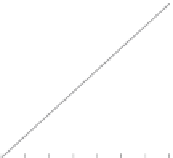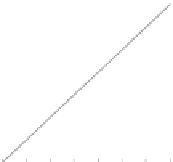Biomedical Engineering Reference
In-Depth Information
(a)
(b)
(c)
7
7
7
1 feature model
3 features model
2 features model
6
6
6
5
5
5
4
4
4
3
3
3
2
2
2
1
1
1
0
0
0
01234567
01234567
01234567
Actual growth rate [fold]
Actual growth rate [fold]
Actual growth rate [fold]
(d)
(e)
7
7
1 feature model
1 feature model
6
6
5
5
4
4
3
3
2
2
1
1
0
0
0
3
5
8
10
13 15 18
0
5000
10000
15000
Increase rate of cell count
(3day/1day) [fold]
Viable cell density
after 1day [pixel]
Fig. 4 Results of prediction using cell yield prediction models. a Prediction model using 1
feature input. b Prediction model using 2 feature inputs. c Prediction model using 3 feature inputs
(the best prediction model). d Correlation plot of growth rate and 1 selected feature (cell density
on day 1). e Correlation plot of growth rate and 1 selected feature (cell growth rate (day 3/day 1).
Each plot represents 1 image dataset. Morphological features in models ab, and c were selected
by a stepwise parameter selection process during model construction. The selected parameters
were (P1) change rate of the standard variation of elliptical form factor (day 1-3) (P2) size of
inner radius on day 3, and (P3) cell number on day 1. Morphological features in models d and
e were selected on the basis of the ''feeling'' of a cell culture expert
To obtain the teacher signal or the target prediction value, which is based on the
experimental data, three volunteers counted the partial sample of the total cell
suspension from three different wells to estimate the average cell yield after
14 days of culture, and calculated the cell growth rate as the ratio of cell yield to
the seeding cell number. The cell growth rate was used as the quantitative teacher
signal in the modeling.
Among the 120 parameters extracted from the image data, three parameters,
change rate of the standard variation of elliptical form factor (day 1-3) (P1), size
of inner radius on day 3 (P2), and cell number on day 1 (P3), were found to be the
best combination of cell morphology information for predicting future cell yield
(average squared error = 0.14). If ±0.5 error can be accepted by the medical
facility, the predict performance of this model is 87%.
The rise in prediction accuracy of models using different numbers of input
features strongly indicated that multiple feature combinations provide higher
prediction accuracy (Fig.
4
a-c). As a comparison, it is interesting that other single
parameters, intentionally selected by cell culture experts, correlated poorly with



























































































Search WWH ::

Custom Search